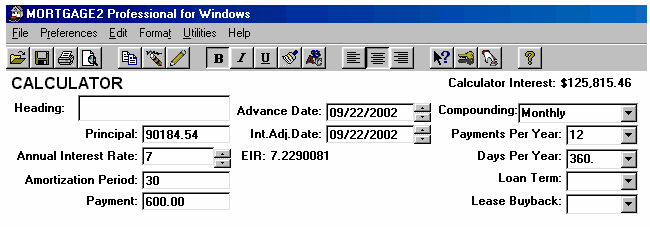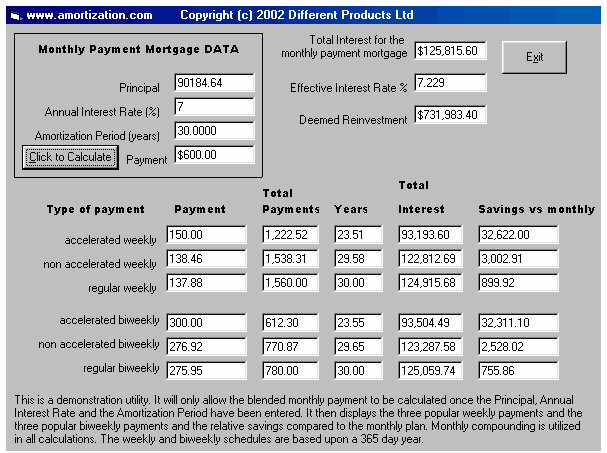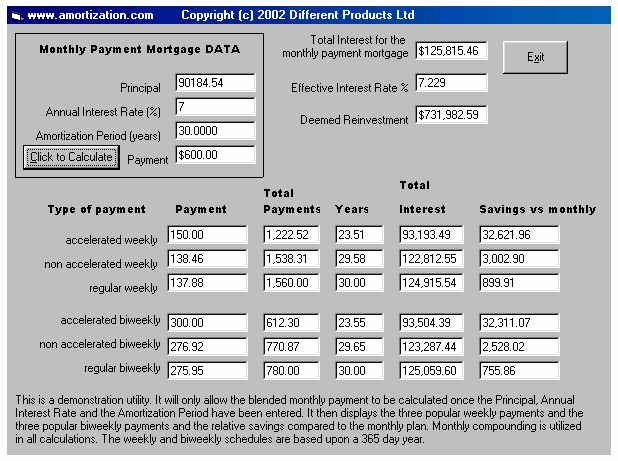Mortgage Tips
Forget the rules of thumb you may have heard over the years concerning mortgages or loans. Banks are in business to lend money and make a profit by charging you interest. The interest you save on your mortgage is a loss to the Bank. It’s that simple!!!
Don’t expect the banks to be forthright or to go into detail on how to save you interest.
There is only one rule to remember, to save money on your mortgage or loan!
Pay back the mortgage as quickly as possible! The instant you are given money by a lender an interest clock starts ticking. Anything you do to satisfy that rule, will minimize your interest costs. The longer you wait to make a payment, the larger the interest charge to you. There are a few ways to repay the principal faster, the best method is to pay more frequently and with a payment as large as possible.
If you borrowed $100,000 on Monday and then won the lottery on Tuesday and paid off your mortgage on Tuesday, you would owe $100,000 plus the interest for the use of the $100,000 for one day. Canadians may not be able to deduct their mortgage interest like Americans however; Canadians can select a mortgage with weekly payments. Weekly and biweekly payment mortgages were introduced in Canada in 1984. There is nothing magic about weekly payment mortgages. All major Banks in Canada will automatically deduct your weekly mortgage payment (or biweekly payment) from your chequing account. A fully amortized mortgage can be achieved using the same mathematical formulas/algebraic equations as if it were monthly payments. A weekly payment amortization schedule similar to a monthly payment schedule could be provided to the borrower upon signing the mortgage.
Americans, do not be misled by lenders who hold the payments (whether weekly or biweekly) in escrow and “do the mathematical adjustments” at the end of the year, this is pure nonsense!!! This is another compelling reason why you need an amortization schedule. You can show an amortization schedule to any accountant and ask them to verify the calculations. This eliminates future problems down the road when your memory is foggy.
If your lender does not offer weekly or biweekly payments then prepay large principal payments along with your regular monthly payments as often as you can afford to and as early on in the mortgage as possible. Prepaying near the end of the life of the mortgage is of little use as the interest damage has already been done. If you are going to play the mortgage game then know the rules of play, your Banker does.
BACK TO THE WEEKLY PAYMENT MORTGAGE
If you required a 30 year mortgage of $90,184.54 and the interest rates were 7% and the lender was using monthly compounding, the monthly payments would be $600 for the next 30 years (assuming the rate is 7% over the 30 years).

If you were experienced at using a financial calculator you could calculate the weekly payment required to amortize the $90,184.54 at 7%, monthly compounding, over the next 30 years. The weekly payment would be $137.88 for the next 30 years. This regular weekly payment is the value that is derived from any financial calculator.
In 1984 the first Canadian lender to offer a weekly payment mortgage also offered variations in the payment amount. This lender arbitrarily coined two weekly payment terms, non accelerated weekly and accelerated weekly.
The regular monthly payment based upon the full amortization period of 30 years is calculated and used as the reference point. In this example, $600 per month. The non accelerated weekly is the yearly cash flow based upon twelve $600 monthly payment divided by 52 payments (600 x 12/52). The accelerated weekly is the yearly cash flow based upon thirteen $600 monthly payment divided by 52 payments (600 x 13/52). None of the financial calculators will directly calculate these two weekly payments because they have nothing to do with the amortization formulas. The screen below shows the difference in savings due to the 3 types of weekly payments.

Follow this procedure and you cannot go wrong! Always ask your lender to calculate the monthly payment first ($600). Divide it by four (13/52=1/4) for the accelerated weekly. Divide it by 4.3333 (12/52 = 4 1/3)for the non accelerated.
The regular weekly payment (as per the calculator) of $137.88 save you $899.92 over the full amortization period of 30 years. The non accelerated weekly saves you $3,002.91 over the 29.58 years. This is called free money! $138.46 taken out of your chequing account each week is the same yearly cash flow as $600 a month being taken out of your chequing account. You save $3,002.91 over the next 29.58 years for doing nothing. The lender has taken the same total amount of money from your account at the end of the year the only difference is the lender takes it out weekly. The accelerated weekly of $150 saves you $32,622 over the next 23.51 years because it is more frequent and a larger payment.
In fact the bigger you make the weekly payment the more you save and the faster you pay off the loan (the amortization period becomes smaller). In this example, if you increased the weekly payment to $200 the mortgage would be paid off in 13.3 years and you would save $77,594 compared to the regular monthly payment of $600.
The above explanation is 100% applicable for both American and Canadian mortgages. The only difference between an American and a Canadian mortgage is American lenders use monthly compounding and Canadian lenders use semi-annual compounding. The difference in compounding effects only the value of the interest factor used to calculate the interest due at the end of each payment period. All the algebraic equations are identical. Anyone that tells you differently is wrongly informed or lying. Canadian mortgages traditionally are amortized for 25 years, whereas American mortgages are usually amortized for 30 years. You can ask for a smaller amortization period however, the salary qualifications usually force most people to chose a 25 or 30 year amortization period. Some lenders in the USA are starting to offer biweekly payment mortgages. At low interest rates the $300 accelerated biweekly payment plan saves you $32,311.07 almost as much as a the $150 accelerated weekly payment plan which saves you $32,621.96 as can be see from the screen capture below.

Use any of the MORTGAGE2 software programs (or ask an accountant) to verify the biweekly payment schedule before signing on the dotted line.
Ask for an amortization schedule, don’t leave the Bank without one. If your lender cannot or will not provide you with an amortization schedule, then change lenders. Click on, more information, if you require further justification for having an amortization schedule. For new home buyers, never, never skip payments early on in the mortgage. Some lenders allow new home owners to skip, for example, the first three monthly payments, in order to help them buy a new stove and fridge. Don’t do it and here is why!
In this day and age of computers and software there is absolutely no excuse for any lender not being able to provide an amortization schedule to a borrower.
